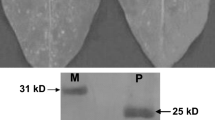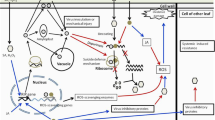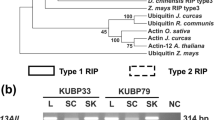Abstract
Main conclusion
The ribosome inactivating protein BE27 displays several biological activities in vitro that could result in a broad action against several types of pathogens.
Beetin 27 (BE27), a ribosome-inactivating protein (RIP) from sugar beet (Beta vulgaris L.) leaves, is an antiviral protein induced by virus and signaling compounds such as hydrogen peroxide and salicylic acid. Its role as a defense protein has been attributed to its RNA polynucleotide:adenosine glycosidase activity. Here we tested other putative activities of BE27 that could have a defensive role against pathogens finding that BE27 displays rRNA N-glycosidase activity against yeast and Agrobacterium tumefaciens ribosomes, DNA polynucleotide:adenosine glycosidase activity against herring sperm DNA, and magnesium-dependent endonuclease activity against the supercoiled plasmid PUC19 (nicking activity). The nicking activity could be a consequence of an unusual conformation of the BE27 active site, similar to that of PD-L1, a RIP from Phytolacca dioica L. leaves. Additionally, BE27 possesses superoxide dismutase activity, thus being able to produce the signal compound hydrogen peroxide. BE27 is also toxic to COLO 320 cells, inducing apoptosis in these cells by either activating the caspase pathways and/or inhibiting protein synthesis. The combined effect of these biological activities could result in a broad action against several types of pathogens such as virus, bacteria, fungi or insects.






Similar content being viewed by others
Abbreviations
- NBT:
-
4-Nitro blue tetrazolium
- SOD:
-
Superoxide dismutase
- SRL:
-
Sarcin ricin loop
References
Aceto S, Di Maro A, Conforto B, Siniscalco GG, Parente A, Delli BP, Gaudio L (2005) Nicking activity on pBR322 DNA of ribosome inactivating proteins from Phytolacca dioica L. leaves. Biol Chem 386:307–317
Alegre C, Iglesias R, Ferreras JM, Carbajales ML, Girbes T (1993) Preparation, optimization and characterization of a polyphenylalanine synthetizing system from Agrobacterium tumefaciens. Cell Mol Biol 39:575–581
Barbieri L, Battelli MG, Stirpe F (1993) Ribosome-inactivating proteins from plants. Biochim Biophys Acta 1154:237–282
Barbieri L, Gorini P, Valbonesi P, Castiglioni P, Stirpe F (1994) Unexpected activity of saporins. Nature 372:624
Barbieri L, Valbonesi P, Bonora E, Gorini P, Bolognesi A, Stirpe F (1997) Polynucleotide:adenosine glycosidase activity of ribosome-inactivating proteins: effect on DNA, RNA and poly(A). Nucleic Acids Res 25:518–522
Barbieri L, Valbonesi P, Righi F, Zuccheri G, Monti F, Gorini P, Samori B, Stirpe F (2000) Polynucleotide:adenosine glycosidase is the sole activity of ribosome-inactivating proteins on DNA. J Biochem 128:883–889
Barbieri L, Polito L, Bolognesi A, Ciani M, Pelosi E, Farini V, Jha AK, Sharma N, Vivanco JM, Chambery A, Parente A, Stirpe F (2006) Ribosome-inactivating proteins in edible plants and purification and characterization of a new ribosome-inactivating protein from Cucurbita moschata. Biochim Biophys Acta 1760:783–792
Bolognesi A, Polito L, Scicchitano V, Orrico C, Pasquinelli G, Musiani S, Santi S, Riccio M, Bortolotti M, Battelli MG (2012) Endocytosis and intracellular localisation of type 1 ribosome-inactivating protein saporin-s6. J Biol Regul Homeost Agents 26:97–109
Citores L, Iglesias R, Ferreras JM (2013) Ribosome inactivating proteins from plants: biological properties and their use in experimental therapy. In: Fang EF, Ng TB (eds) Antitumor potential and other emerging medicinal properties of natural compounds. Springer, Dordrecht, pp 127–143
Corrado G, Bovi PD, Ciliento R, Gaudio L, Di Maro A, Aceto S, Lorito M, Rao R (2005) Inducible expression of a Phytolacca heterotepala ribosome-inactivating protein leads to enhanced resistance against major fungal pathogens in tobacco. Phytopathology 95:206–215
Das MK, Sharma RS, Mishra V (2012) Induction of apoptosis by ribosome inactivating proteins: importance of N-glycosidase activity. Appl Biochem Biotechnol 166:1552–1561
de Virgilio M, Lombardi A, Caliandro R, Fabbrini MS (2010) Ribosome-inactivating proteins: from plant defense to tumor attack. Toxins 2:2699–2737
Di Maro A, Chambery A, Daniele A, Casoria P, Parente A (2007) Isolation and characterization of heterotepalins, type 1 ribosome-inactivating proteins from Phytolacca heterotepala leaves. Phytochemistry 68:767–776
Di Maro A, Chambery A, Carafa V, Costantini S, Colonna G, Parente A (2009) Structural characterization and comparative modeling of PD-Ls 1–3, type 1 ribosome-inactivating proteins from summer leaves of Phytolacca dioica L. Biochimie 91:352–363
Di Maro A, Citores L, Russo R, Iglesias R, Ferreras JM (2014) Sequence comparison and phylogenetic analysis by the maximum likelihood method of ribosome-inactivating proteins from angiosperms. Plant Mol Biol 85:577–588
Dowd PF, Johnson ET, Price NP (2012) Enhanced pest resistance of maize leaves expressing monocot crop plant-derived ribosome-inactivating protein and agglutinin. J Agric Food Chem 60:10768–10775
Dunaeva M, Goebel C, Wasternack C, Parthier B, Goerschen E (1999) The jasmonate-induced 60 kDa protein of barley exhibits N-glycosidase activity in vivo. FEBS Lett 452:263–266
Endo Y, Tsurugi K (1988) The RNA N-glycosidase activity of ricin A-chain. The characteristics of the enzymatic activity of ricin A-chain with ribosomes and with rRNA. J Biol Chem 263:8735–8739
Engelberth J, Contreras CF, Viswanathan S (2012) Transcriptional analysis of distant signaling induced by insect elicitors and mechanical wounding in Zea mays. PLoS ONE 7:e34855
Ferreras JM, Alegre C, Iglesias R, Girbes T (1994) Sensitivity of translation by Brevibacterium lactofermentum ribosomes to type 1 and type 2 ribosome-inactivating proteins. Biosci Biotechnol Biochem 58:1458–1462
Ferreras JM, Iglesias R, Barbieri L, Alegre C, Bolognesi A, Rojo MA, Carbajales ML, Escarmis C, Girbes T (1995) Effects and molecular action of ribosome-inactivating proteins on ribosomes from Streptomyces lividans. Biochim Biophys Acta 1243:85–93
Ferreras JM, Citores L, Iglesias R, Jimenez P, Girbes T (2011a) Use of ribosome-inactivating proteins from Sambucus for the construction of immunotoxins and conjugates for cancer therapy. Toxins 3:420–441
Ferreras JM, Citores L, Iglesias R, Souza AM, Jimenez P, Gayoso MJ, Girbes T (2011b) Occurrence of the type two ribosome-inactivating protein nigrin b in elderberry (Sambucus nigra L.) bark. Food Res Int 44:2798–2805
Fong WP, Mock WY, Ng TB (2000) Intrinsic ribonuclease activities in ribonuclease and ribosome-inactivating proteins from the seeds of bitter gourd. Int J Biochem Cell Biol 32:571–577
Gill SS, Tuteja N (2010) Reactive oxygen species and antioxidant machinery in abiotic stress tolerance in crop plants. Plant Physiol Biochem 48:909–930
Girbes T, Ferreras JM (1998) Ribosome-inactivating proteins from plants. Recent Res Devel Agric Biol Chem 2:1–16
Girbes T, Cabrer B, Modolell J (1979) Preparation and assay of purified Escherichia coli polysomes devoid of free ribosomal subunits and endogenous GTPase activities. Methods Enzymol 59:353–362
Girbes T, Barbieri L, Ferreras M, Arias FJ, Rojo MA, Iglesias R, Alegre C, Escarmis C, Stirpe F (1993) Effects of ribosome-inactivating proteins on Escherichia coli and Agrobacterium tumefaciens translation systems. J Bacteriol 175:6721–6724
Girbes T, de Torre C, Iglesias R, Ferreras JM, Mendez E (1996) RIP for viruses. Nature 379:777–778
Girbes T, Ferreras JM, Arias FJ, Stirpe F (2004) Description, distribution, activity and phylogenetic relationship of ribosome-inactivating proteins in plants, fungi and bacteria. Mini Rev Med Chem 4:461–476
Greiner-Stoeffele T, Grunow M, Hahn U (1996) A general ribonuclease assay using methylene blue. Anal Biochem 240:24–28
Hao Z, Wang L, He Y, Liang J, Tao R (2011) Expression of defense genes and activities of antioxidant enzymes in rice resistance to rice stripe virus and small brown planthopper. Plant Physiol Biochem 49:744–751
Huang PL, Chen HC, Kung HF, Huang PL, Huang P, Huang HI, Lee-Huang S (1992) Anti-HIV plant proteins catalyze topological changes of DNA into inactive forms. BioFactors 4:37–41
Huang M, Hou P, Wei Q, Xu Y, Chen A (2008) A ribosome-inactivating protein (curcin 2) induced from Jatropha curcas can reduce viral and fungal infection in transgenic tobacco. Plant Growth Regul 54:115–123
Iglesias R, Perez Y, de Torre C, Ferreras JM, Antolin P, Jimenez P, Rojo MA, Mendez E, Girbes T (2005) Molecular characterization and systemic induction of single-chain ribosome-inactivating proteins (RIPs) in sugar beet (Beta vulgaris) leaves. J Exp Bot 56:1675–1684
Iglesias R, Perez Y, Citores L, Ferreras JM, Mendez E, Girbes T (2008) Elicitor-dependent expression of the ribosome-inactivating protein beetin is developmentally regulated. J Exp Bot 59:1215–1223
Kalb VF Jr, Bernlohr RW (1977) A new spectrophotometric assay for protein in cell extracts. Anal Biochem 82:362–371
LeBrasseur ND, MacIntosh GC, Perez-Amador MA, Saitoh M, Green PJ (2002) Local and systemic wound-induction of RNase and nuclease activities in Arabidopsis: RNS1 as a marker for a JA-independent systemic signaling pathway. Plant J 29:393–403
Nicolas E, Beggs JM, Taraschi TF (2000) Gelonin is an unusual DNA glycosylase that removes adenine from single-stranded DNA, normal base pairs and mismatches. J Biol Chem 275:31399–31406
Parente A, Conforto B, Di Maro A, Chambery A, De LP, Bolognesi A, Iriti M, Faoro F (2008) Type 1 ribosome-inactivating proteins from Phytolacca dioica L. leaves: differential seasonal and age expression, and cellular localization. Planta 228:963–975
Park SW, Vepachedu R, Sharma N, Vivanco JM (2004) Ribosome-inactivating proteins in plant biology. Planta 219:1093–1096
Peumans WJ, Van Damme EJM (2010) Evolution of plant ribosome-inactivating proteins. In: Lord JM, Hartley MR (eds) Toxic plant proteins—series Plant cell monographs, vol 18. Springer, Heidelberg, pp 1–26
Peumans WJ, Hao O, Van Damme EJ (2001) Ribosome inactivating proteins from plants: more than RNA N-glycosidases? FASEB J 15:11493–11506
Prestle J, Schonfelder M, Adam G, Mundry KW (1992) Type 1 ribosome-inactivating proteins depurinate plant 25S rRNA without species specificity. Nucleic Acids Res 20:3179–3182
Puri M, Kaur I, Perugini MA, Gupta RC (2012) Ribosome-inactivating proteins: current status and biomedical applications. Drug Discov Today 17:774–783
Qian Q, Huang L, Yi R, Wang S, Ding Y (2014) Enhanced resistance to blast fungus in rice (Oryza sativa L.) by expressing the ribosome-inactivating protein alpha-momorcharin. Plant Sci 217–218:1–7
Qin X, Zheng X, Shao C, Gao J, Jiang L, Zhu X, Yan F, Tang L, Xu Y, Chen F (2009) Stress-induced curcin-L promoter in leaves of Jatropha curcas L. and characterization in transgenic tobacco. Planta 230:387–395
Rippmann JF, Michalowski CB, Nelson DE, Bohnert HJ (1997) Induction of a ribosome-inactivating protein upon environmental stress. Plant Mol Biol 35:701–709
Robertus JD, Monzingo AF (2004) The structure of ribosome inactivating proteins. Mini Rev Med Chem 4:477–486
Roncuzzi L, Gasperi-Campani A (1996) DNA-nuclease activity of the single-chain ribosome-inactivating proteins dianthin 30, saporin 6 and gelonin. FEBS Lett 392:16–20
Roy A, Kucukural A, Zhang Y (2010) I-TASSER: a unified platform for automated protein structure and function prediction. Nat Protoc 5:725–738
Ruggiero A, Di Maro A, Severino V, Chambery A, Berisio R (2009) Crystal structure of PD-L1, a ribosome inactivating protein from Phytolacca dioica L. leaves with the property to induce DNA cleavage. Biopolymers 91:1135–1142
Sallustio S, Stanley P (1990) Isolation of Chinese hamster ovary ribosomal mutants differentially resistant to ricin, abrin, and modeccin. J Biol Chem 265:582–588
Sawasaki T, Nishihara M, Endo Y (2008) RIP and RALyase cleave the sarcin/ricin domain, a critical domain for ribosome function, during senescence of wheat coleoptiles. Biochem Biophys Res Commun 370:561–565
Severino V, Chambery A, Di Maro A, Marasco D, Ruggiero A, Berisio R, Giansanti F, Ippoliti R, Parente A (2010) The role of the glycan moiety on the structure-function relationships of PD-L1, type 1 ribosome-inactivating protein from P. dioica leaves. Mol BioSyst 6:570–579
Shahidi-Noghabi S, Van Damme EJ, Mahdian K, Smagghe G (2010) Entomotoxic action of Sambucus nigra agglutinin I in Acyrthosiphon pisum aphids and Spodoptera exigua caterpillars through caspase-3-like-dependent apoptosis. Arch Insect Biochem Physiol 75:207–220
Shahidi-Noghabi S, Van Damme EJ, De Vos WH, Smagghe G (2011) Internalization of Sambucus nigra agglutinins I and II in insect midgut CF-203 cells. Arch Insect Biochem Physiol 76:211–222
Sharma N, Park SW, Vepachedu R, Barbieri L, Ciani M, Stirpe F, Savary BJ, Vivanco JM (2004) Isolation and characterization of an RIP (ribosome-inactivating protein)-like protein from tobacco with dual enzymatic activity. Plant Physiol 134:171–181
Song SK, Choi Y, Moon YH, Kim SG, Choi YD, Lee JS (2000) Systemic induction of a Phytolacca insularis antiviral protein gene by mechanical wounding, jasmonic acid, and abscisic acid. Plant Mol Biol 43:439–450
Stirpe F (2005) Ribosome-inactivating proteins. In: Wiley RG, Lappi DA (eds) Molecular neurosurgery with targeted toxins. Humana Press Inc., Totowa, pp 9–29
Stirpe F, Barbieri L, Gorini P, Valbonesi P, Bolognesi A, Polito L (1996) Activities associated with the presence of ribosome-inactivating proteins increase in senescent and stressed leaves. FEBS Lett 382:309–312
Tahirov TH, Lu TH, Liaw YC, Chen YL, Lin JY (1995) Crystal structure of abrin-a at 2.14 A. J Mol Biol 250:354–367
Tan YC, Yeoh KA, Wong MY, Ho CL (2013) Expression profiles of putative defence-related proteins in oil palm (Elaeis guineensis) colonized by Ganoderma boninense. J Plant Physiol 170:1455–1460
Tertivanidis K, Goudoula C, Vasilikiotis C, Hassiotou E, Perl-Treves R, Tsaftaris A (2004) Superoxide dismutase transgenes in sugarbeets confer resistance to oxidative agents and the fungus C. beticola. Transgenic Res 13:225–233
Valbonesi P, Barbieri L, Bolognesi A, Bonora E, Polito L, Stirpe F (1999) Preparation of highly purified momordin II without ribonuclease activity. Life Sci 65:1485–1491
van Loon LC, Rep M, Pieterse CM (2006) Significance of inducible defense-related proteins in infected plants. Annu Rev Phytopathol 44:135–162
Waters MG, Blobel G (1986) Secretory protein translocation in a yeast cell-free system can occur posttranslationally and requires ATP hydrolysis. J Cell Biol 102:1543–1550
Acknowledgments
This work was supported by Grants FISPI04/1279 to J. M. F., BIO39/VA42/10 to L. C. and funds from the Second University of Naples. We thank Judy Callaghan (Monash University, Melbourne, Australia) for correcting the manuscript.
Author information
Authors and Affiliations
Corresponding author
Rights and permissions
About this article
Cite this article
Iglesias, R., Citores, L., Di Maro, A. et al. Biological activities of the antiviral protein BE27 from sugar beet (Beta vulgaris L.). Planta 241, 421–433 (2015). https://doi.org/10.1007/s00425-014-2191-2
Received:
Accepted:
Published:
Issue Date:
DOI: https://doi.org/10.1007/s00425-014-2191-2




